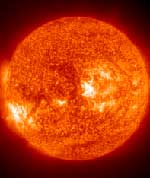
Image credit: SOHO
A gigantic group of sunspots, 10 times larger than the Earth, have been active on the surface of the Sun for the past few days. Solar astronomers have spotted several Coronal Mass Ejections (CMEs) blasting out of the sunspots, and one of them seems to be coming our way. Once it reaches the Earth, it will interact with the planet’s geomagnetic field, and potentially disrupt communications satellites. Beautiful auroras (Northern Lights) will probably be visible, even from middle latitudes. The solar material is expected to sweep past the Earth Friday or Saturday.
Forecasters at the NOAA Space Environment Center in Boulder, Colo., observed two dynamic areas of the sun, one of which has produced a coronal mass ejection, or CME, Wednesday morning at 3 a.m. EDT that appears to be Earth-directed. The forecasters are predicting a strong geomagnetic storm, G-3 on the NOAA Space Weather Scales, that should reach Earth on Friday, October 24. (Click here to view larger image from the SOHO spacecraft of the intense solar activity on the sun taken Oct. 21, 2003. Click here to view high resolution version, which is a large file. Click here to view latest images. Please credit ?SOHO.?)
NOAA Region 484 developed rapidly over the past three days and is now one of the largest sunspot clusters to emerge during Solar Cycle 23. It is about 10 times larger than the Earth. This region, which is nearing the center of the sun, already produced a major flare, R-3 on the NOAA Space Weather Scales, producing a radio blackout on October 19 at 12:50 p.m EDT. The region continues to grow, and additional substantial flare activity is likely.
Larry Combs, a forecaster with the NOAA Space Environment Center?s Space Weather Operations, said that this region has developed rapidly over the last three to four days. ?It?s somewhat unusual to have this much activity when we?re approximately three-and-a-half years past solar maximum,? he said. ?In fact, just last week, solar activity was very low with an almost spotless sun.? Solar cycles of high and low activity repeat about every eleven years, and the sun has been moving towards solar minimum for the past three years.
A second intense active region is rotating on the southeast quadrant of the sun. Although the sunspot group is not yet visible, two powerful eruptions occurred on October 21 as seen from the LASCO instrument on the SOHO spacecraft. These eruptions may herald the arrival of another volatile active center with the potential to impact various Earth systems.
Further major eruptions are possible from these active regions as they rotate across the face of the sun over the next two weeks. Satellite and other spacecraft operations, power systems, high frequency communications, and navigation systems may experience disruptions over this two-week period.
NOAA is dedicated to enhancing economic security and national safety through the prediction and research of weather and climate-related events and providing environmental stewardship of the nation?s coastal and marine resources. NOAA is part of the U.S. Department of Commerce.
Original Source: NOAA News Release
